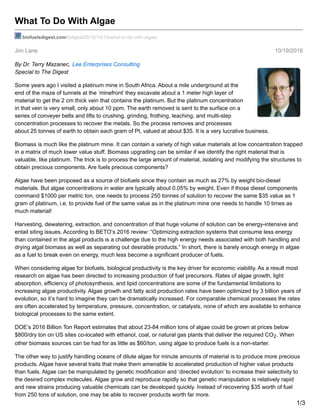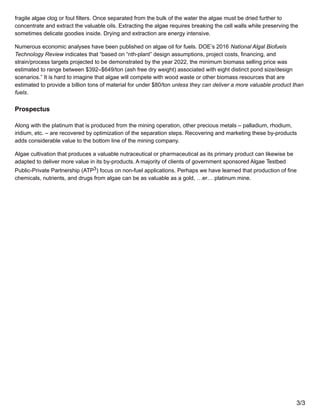biofuelsdigest.com-What To Do With Algae 19-oct-16
- 1. Jim Lane 10/19/2016 What To Do With Algae biofuelsdigest.com/bdigest/2016/10/19/what-to-do-with-algae/ By Dr. Terry Mazanec, Lee Enterprises Consulting Special to The Digest Some years ago I visited a platinum mine in South Africa. About a mile underground at the end of the maze of tunnels at the âminefrontâ they excavate about a 1 meter high layer of material to get the 2 cm thick vein that contains the platinum. But the platinum concentration in that vein is very small, only about 10 ppm. The earth removed is sent to the surface on a series of conveyer belts and lifts to crushing, grinding, frothing, leaching, and multi-step concentration processes to recover the metals. So the process removes and processes about 25 tonnes of earth to obtain each gram of Pt, valued at about $35. It is a very lucrative business. Biomass is much like the platinum mine. It can contain a variety of high value materials at low concentration trapped in a matrix of much lower value stuff. Biomass upgrading can be similar if we identify the right material that is valuable, like platinum. The trick is to process the large amount of material, isolating and modifying the structures to obtain precious components. Are fuels precious components? Algae have been proposed as a source of biofuels since they contain as much as 27% by weight bio-diesel materials. But algae concentrations in water are typically about 0.05% by weight. Even if those diesel components command $1000 per metric ton, one needs to process 250 tonnes of solution to recover the same $35 value as 1 gram of platinum, i.e. to provide fuel of the same value as in the platinum mine one needs to handle 10 times as much material! Harvesting, dewatering, extraction, and concentration of that huge volume of solution can be energy-intensive and entail siting issues. According to BETOâs 2016 review: âOptimizing extraction systems that consume less energy than contained in the algal products is a challenge due to the high energy needs associated with both handling and drying algal biomass as well as separating out desirable products.â In short, there is barely enough energy in algae as a fuel to break even on energy, much less become a significant producer of fuels. When considering algae for biofuels, biological productivity is the key driver for economic viability. As a result most research on algae has been directed to increasing production of fuel precursors. Rates of algae growth, light absorption, efficiency of photosynthesis, and lipid concentrations are some of the fundamental limitations to increasing algae productivity. Algae growth and fatty acid production rates have been optimized by 3 billion years of evolution, so itâs hard to imagine they can be dramatically increased. For comparable chemical processes the rates are often accelerated by temperature, pressure, concentration, or catalysts, none of which are available to enhance biological processes to the same extent. DOEâs 2016 Billion Ton Report estimates that about 23-84 million tons of algae could be grown at prices below $800/dry ton on US sites co-located with ethanol, coal, or natural gas plants that deliver the required CO2. When other biomass sources can be had for as little as $60/ton, using algae to produce fuels is a non-starter. The other way to justify handling oceans of dilute algae for minute amounts of material is to produce more precious products. Algae have several traits that make them amenable to accelerated production of higher value products than fuels. Algae can be manipulated by genetic modification and âdirected evolutionâ to increase their selectivity to the desired complex molecules. Algae grow and reproduce rapidly so that genetic manipulation is relatively rapid and new strains producing valuable chemicals can be developed quickly. Instead of recovering $35 worth of fuel from 250 tons of solution, one may be able to recover products worth far more. 1/3
- 2. Algae Developers Some algae are known to produce valuable molecules naturally. The nutritional supplemental omega-3 fatty acids EPA and DHA are produced by some algae. These materials play essential roles in human and animal nutrition, including during neonatal development and in adult cardiovascular health. With a wholesale value of up to $500/kg their value more closely resembles the value of the platinum at the bottom of that mile deep mine. The best selectivities to BHA or EPA of the total fatty acids in naturally occurring algae are about 40% w/w. However, genetic manipulations have allowed researchers to change the selectivities of BHA and EPA in transgenic algae strains. It is no wonder that processes for the production and extraction of BHA and EPA from algae are under development. Sapphire Energy, Cellana, Qualitas Health, Heliae, DSM, TerraVia (Solazyme), Fermentalg, and others are in the hunt. Solazyme (now TerraVia) was founded in 2003 with a vision of using algae to convert sugars to renewable energy and transportation fuels. From early days Solazyme was diversified, producing personal care products as well as biofuels. While Solazymeâs anti-aging skincare line, Algenist, successfully penetrated the market, the fuels only reached demonstrations. In 2015, Solazyme threw in the towel on fuels to focus on nutrition and personal care products. The name change to TerraVia reflects the companyâs new focus on food, nutrition, and specialty ingredients, as does its $200 million deal to supply algae oil to Unilever for personal care products. Cellana is focused on optimizing production, and has operated a 6-acre demonstration facility in Kona HI since 2009, producing over 20 metric tons of whole algae (dry weight) to date. Its outdoor algae production ALDUOâĒ technology has been validated with diverse algae strains. Cellanaâs vision is for an integrated refinery that manufactures nutraceuticals, animal feed, and fuels. As the nutraceuticals BHA and EPA provide > 90% of the projected revenue, the economic viability of the enterprise is wholly dependent on increasing the yield or reducing the separation costs of these materials. Sapphire Energy was founded in 2007 with the aim of producing biofuels from genetically modified algae. They mutated, evolved, and selected algae strains for productivity, biocide tolerance, pest resistance, harvestability, temperature tolerance, and photosynthetic efficiency to produce âGreen Crude.â However, in 2015, âunderlying investment and economic conditionsâ dictated that they pivot to producing omega-3 fatty acids for nutrition, with fuels as a byproduct. Recently, Monsanto made a small investment in Sapphire as the two will work together to find genes that improve agricultural crops by testing them first in algae. Sapphire still maintains a 22-acre facility in La Cruces and a 96 acre facility in Columbus NM that will allow for rapid scale up. The US DOE has put its$15 million thumb on the scale to boost the fortunes of three consortia among government labs and industrial partners looking to dramatically improve the economics of algae production. Global Algae Innovations heads a consortium to combine improved cultivation and pre-processing technologies with strain development. An Algenol-led group will optimize productivity of cyanobacteria, conversion to a biofuel intermediate, and costs of the photo-bioreactor. MicroBio Engineering will focus on integrating high yields of biofuels with wastewater treatment, co-products, and carbon-dioxide mitigation. Algae Issues Scale up of algae derived fuels or chemicals processes faces many challenges. Algae grow in bioreactors that are either open ponds or closed reactors. Open ponds are subject to evaporation of excessive amounts of water and invasion by other species that can contaminate the âcropâ or crash growth. Crashed batches must be isolated from healthy batches and re-seeded. Closed reactors are more expensive and present maintenance constraints. Nutrients, sunlight, and CO2 need to be supplied economically in a continuous fashion as well. Microalgae are quite small and are grown in low concentration. Harvesting is a challenge because the tiny and 2/3
- 3. fragile algae clog or foul filters. Once separated from the bulk of the water the algae must be dried further to concentrate and extract the valuable oils. Extracting the algae requires breaking the cell walls while preserving the sometimes delicate goodies inside. Drying and extraction are energy intensive. Numerous economic analyses have been published on algae oil for fuels. DOEâs 2016 National Algal Biofuels Technology Review indicates that âbased on ânth-plantâ design assumptions, project costs, financing, and strain/process targets projected to be demonstrated by the year 2022, the minimum biomass selling price was estimated to range between $392â$649/ton (ash free dry weight) associated with eight distinct pond size/design scenarios.â It is hard to imagine that algae will compete with wood waste or other biomass resources that are estimated to provide a billion tons of material for under $80/ton unless they can deliver a more valuable product than fuels. Prospectus Along with the platinum that is produced from the mining operation, other precious metals â palladium, rhodium, iridium, etc. â are recovered by optimization of the separation steps. Recovering and marketing these by-products adds considerable value to the bottom line of the mining company. Algae cultivation that produces a valuable nutraceutical or pharmaceutical as its primary product can likewise be adapted to deliver more value in its by-products. A majority of clients of government sponsored Algae Testbed Public-Private Partnership (ATP3) focus on non-fuel applications. Perhaps we have learned that production of fine chemicals, nutrients, and drugs from algae can be as valuable as a gold, âĶerâĶ platinum mine. 3/3


